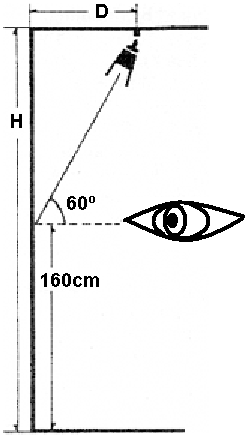Track Lighting – Canadian Conservation Institute (CCI) Notes 2/3
(PDF Version, 630 KB)
CCI Note 2/3 is part of CCI Notes Series 2 (Preventive Conservation)
Introduction
Track lighting is perhaps the most flexible system for museums and galleries. This is not to say that the fluorescent tube should not be used; each system has its advantages and disadvantages.
Installation

This optimum distance should be carefully observed because it gives good illumination for objects of moderate size. However, when large objects are exhibited on walls, the top of the object ends up being very close to the lamp if this formula is followed.
In these situations, at least an extra 30 cm should be added to the calculated distance.
The most flexibility will be offered by a double track system where the tracks are 60 cm to 90 cm apart. An alternative to this is a single track with short, regular sections perpendicular to the main track.
The bulb should be slightly recessed in the fixture. This will eliminate direct glare while not impeding the light beam.
Light Level Reduction
To reduce the amount of damage done to objects by illumination during display, it is important to be able to adjust the lighting levels. Each length of track should be equipped with a dimmer control. If this proves to be too expensive, at least one dimmer for each wall section is recommended. Once the light levels have been adjusted for a particular exhibition, a piece of tape should be placed over the lever or knob of the dimmer to prevent accidental changes.
Whenever the output of an incandescent lamp is reduced by dimming, the light becomes more yellow. This undesirable tendency can be reduced by using the Daylite Fluro-Spray Floodlight (R-40) manufactured by Duro-Test Electric Ltd. The advantage of this lamp is that it can be dimmed to about half intensity before its light becomes as yellow in appearance as that of ordinary floodlights at full power.
There are several ways to reduce the illumination levels on art objects and artifacts. One of the most effective is to reduce the number of lamps in the system. Changing the type of lamps should also be considered; spotlights can be replaced by floodlights or by lamps of lower wattage (Table 1). It should be noted that the lower the wattage, the more yellow the light.
The location of the lamp relative to the object will also have a direct bearing on the light level. Two factors are involved: the distance between the lamp and the object, and the angle of incidence of the light beam on the surface of the object.
Table 1 lists the illumination levels of various lamps at different distances. As can be seen, a small increase in the distance will drastically reduce the light level. This Table also illustrates the differences in intensity between lamps of various types, and can be used to choose the type of lamp to be installed in a display area.
Table 2 shows that reduced lighting levels can be achieved by increasing the angle at which the light strikes the object. Angles greater than 60° will accentuate surface detail and texture, an effect which may be undesirable in some displays.
| Lamp | Distance from Lamp | |||||||
|---|---|---|---|---|---|---|---|---|
| Wattage (W) | Other characteristics | 120 cm | 150 cm | 180 cm | 210 cm | 240 cm | 270 cm | 300 cm |
| 150 W | Spot (R-40) | N/A | 3200 | 1900 | 1300 | 1050 | 850 | N/A |
| 75 W | Spot (R-30) | N/A | 850 | 620 | 450 | 350 | 280 | 230 |
| 150 W | Flood (R-40) | N/A | 590 | 425 | 320 | 250 | 205 | 175 |
| 75 W | Flood (R-30) | 200 | 130 | 95 | 70 | 55 | 45 | N/A |
| 150 W | Fluro-Spray spot (R-30) | 200 | 130 | 95 | 75 | 60 | 50 | N/A |
| Angle and ReductionTable footnote 2 | Light Intensity Reduction Percentage |
|---|---|
| 0° | 0% |
| 10° | 1.5% |
| 20° | 6% |
| 30° | 13.4% |
| 40° | 23.4% |
| 50° | 35.7% |
| 60° | 50% |
Further Reading
-
Bergeron, André, ed. L'éclairage dans les institutions muséales. Québec : Musée de la civilisation et Société des musées québécois, .
-
Canadian Conservation Institute. Daylite Fluro-Spray Floodlight. CCI Notes nº 2/2. Ottawa: Canadian Conservation Institute, .
-
Illuminating Engineering Society. IES Lighting Handbook: The Standard Lighting Guide. New York: Illuminating Engineering Society, .
-
Lafontaine, Raymond H. Environmental Norms for Canadian Museums, Art Galleries and Archives. Technical Bulletin Nº 5. Ottawa: Canadian Conservation Institute, .
Copies are also available in French.
Texte également publié en version française.
© Communications Canada,
Cat. Nº NM95-57/2-3-1983E
ISSN 0714-6221